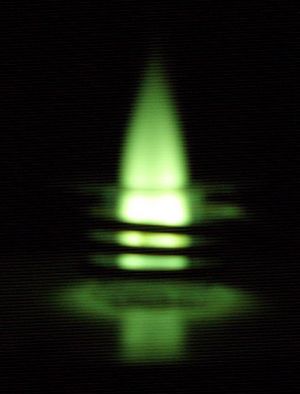Inductively coupled plasma facts for kids

An inductively coupled plasma (often called ICP) is a special kind of plasma. Think of plasma as a super-hot, electrically charged gas. In an ICP, electromagnetic energy makes charged particles, called ions, swirl around. This movement creates a lot of energy in the form of heat.
Contents
How an ICP Works
Most ICPs use a gas called argon as their main fuel. It takes quite a bit of argon, usually at least 5 liters every minute. This can make running an ICP a bit expensive.
To start, a spark from a tesla coil zaps the argon atoms. This turns them into ions. These new ions then get caught in a strong magnetic field. This makes them spin around very fast, creating lots of heat and extremely high temperatures. This heat causes even more argon atoms to turn into ions. After a short time, the ICP torch gets incredibly hot, reaching temperatures between 6,000 and 10,000 Kelvin. That's hotter than the surface of the sun!
What ICPs Are Used For
The super high temperatures made by ICPs make them very useful in science. Scientists love them because they give clear and strong signals, with very little unwanted noise or interference. Also, the information from ICP experiments is often very straightforward. This makes it easy for scientists to figure out how much of something is in a sample.
Some common ways ICPs are used include:
- ICP-AES: This method uses the light given off by atoms to identify them.
- ICP-MS: This technique measures the mass of atoms to identify them.
- ICP-RIE: This is a process used in making tiny electronic parts.
Exploring Samples with ICP-AES
Inductively coupled plasma atomic emission spectroscopy (ICP-AES) is one of the most popular uses for ICPs. Here's how it works:
The super-hot plasma heats up a sample. When atoms in the sample get hot enough, their electrons jump to a higher energy level. But electrons don't like staying in high-energy states for long. When they "fall" back down to their normal, lower energy level (called the ground state), they release energy as tiny packets of light called photons.
A special detector measures the wavelength (or color) of this light. Each type of atom gives off light at its own unique wavelengths. This is like a fingerprint for atoms! By looking at these wavelengths, scientists can figure out exactly which atoms are in the sample. The brightness, or intensity, of the light also tells them how much of each atom is present. ICP-AES is often used to find harmful substances like heavy metals. It's also great for many other chemical studies.
What Elements Can ICP Detect?
An inductively coupled plasma source can help scientists find about 60 different elements. This includes most alkali metals, alkaline earth metals, metalloids, all transition metals, and some f-block elements.
Related pages
Images for kids


